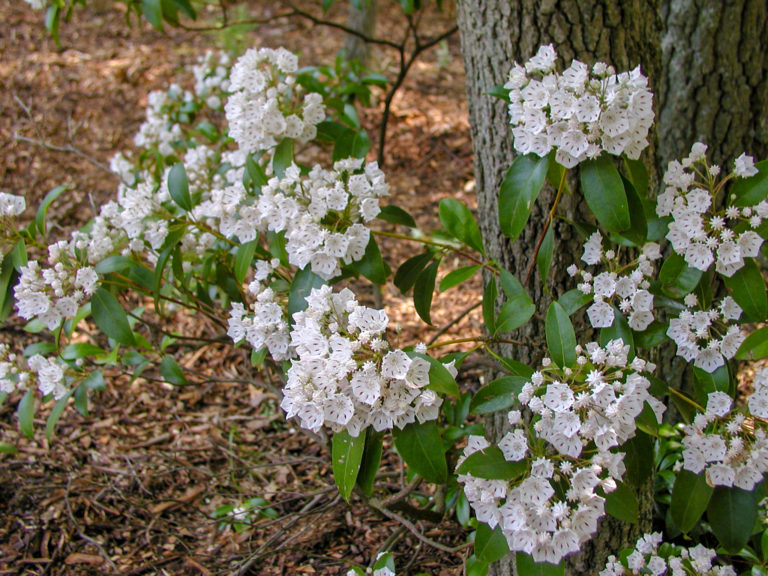Many people know Mountain Laurel as a stunning native shrub which is a spectacular sight in our mountains in May and June, but many don’t realize that it also grows in rocky floodplains of our rivers in the piedmont. Since we collect our seed from natural stands on the Haw River, our plants are adapted to lower elevations, and we consciously call our plants Piedmont Mountain Laurel. The shrub is common in the Appalachian Mountains, plateaus, piedmont, and coastal plains from southeast Maine to the Florida panhandle, west to Louisiana, and north through southern Indiana to southern Quebec. The shrub is slow-growing, 8-12′ high (much taller and a tree form in certain environments), with contorted, attractively exfoliating bark, handsome evergreen foliage and amazing flowers which vary from white through various shades of rose with contrasting markings — jewels in the spring sunshine. Sunshine enhances flowering, but partial sun is best, as well as moist, well drained, acidic soil conditions, with emphasis on both acidic and well drained adjectives. This is a magnificent, fascinating, but slow growing plant, so think Beauty for the Future!
NURSERY HOURS
Wednesday: 10-4 Thursday: 10-6 Friday-Saturday: 10-4 Sunday: 12-4
Kalmia latifolia L.

Key Info
Common Names: Piedmont Mountain Laurel, Calico Bush, Ivy Bush, Spoonwood, Calico Bush, American Laurel.
Family Names: Ericaceae (Heather Family)
Plant Type: Tree / Shrub
Moisture Requirement: Moist well drained
Leaf Retention: Evergreen
Bloom Times: May
Flower Color: White, rose, pink
Special Characteristics: Good for hedges, Long lived, Interesting bark, Interesting form, Slow growing, Tolerates shade, Good for wildlife cover/habitat, Tolerates drought
Additional Info
Habit: The shrub is usually dense, rounded, multi-stemmed in sufficient light and moisture, more open in dry shade; stems are long and narrow, gnarled and twisted, with furrows and ridges; bark shreddy, often sloughing in narrow strips or flakes; below a basal burl, mountain laurel has a root system which is a thick, fibrous mass of relatively fine roots supporting numerous other vertical and horizontal roots that may reach up to 30 inches in depth.
Height: 5' to 15'
Spread: 5' to 15'
Soil Conditions: Moist, Well drained; acid (4.5 - 5.5) pH; sandy, rocky, loamy texture.
Leaves: Alternate, leathery, elliptic, glossy leaves (to 5” long x 2" wide) with entire margins, prominent, raised mid-vein, and pointy tip; dark shiny green above and yellow green beneath.
Flowers (or reproductive structures: The showy flowers are in clusters (technically compound corymbs) 3 to 6 inches across, appearing at the ends of branches and covering the plant (if light and moisture are sufficient) for several weeks in early summer. The individual flower bud is small, sweetly fluted and acorn-shaped, and expands and opens to become a delicate, 1-inch, five-sided cup containing the colorful pistil and stamens.
Fruit: Seeds, which are wind-dispersed, are contained in small, round, dehiscent, fruit-like capsules each containing 300 to 700 seeds. Seedfall begins in the fall and continues through to the spring.
Natural Distribution: Rocky outcrops on floodplains, xeric sites with rocky or sandy acidic soils on southern-facing slopes, ridges, and mountain hillsides. It sometimes occurs on well-drained mesic floodplain soils.
USDA Hardiness Zone: 4 to 9
USDA Wetland Indicator Status in NC: FACU
Pollination: Bumblebees are the primary species of insect-mediated pollination. Mountain Laurel anthers are positioned under tension which is suddenly released when a bumblebee or other insect lands on the flower delivering the pollen onto the insect. If the flowers remain unpollinated, the anther will self-release pollen onto the flower's own pistil. Insect flower visitation depends on annual nectar production rates, which vary from year to year. (see FEIS website)
Wildlife Connections: Mountain Laurel is a larval host and/or nectar source for the Laurel Sphinx Moth.
Propagation: From seeds.
